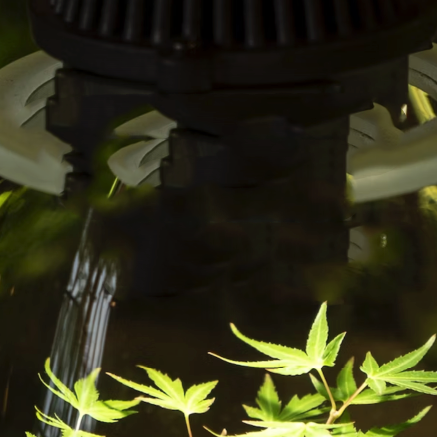Thrips - How they can cause constant damage to your grow
Thrips - these tiny little pests are usually less than a millimetre long and look like slender, elongated flies. Because they are so small they can be difficult to see. They can cause untold damage to all types of crop, not just indoor grows. They can be very difficult to get rid of but by using the right techniques they can be successfully controlled to limit the effect that they have on your plants.
The picture on the left shows the first 2 laval stages and an adult.
Thrips cause the damage by puncturing the leaves and then sucking out the juice. They do this over and over until the leaf is mottled with hundreds, if not thousands, of white dots. The leafs ability to photosynthesise and function normally drops dramatically. Eventually the leaf will die and fall off. Quite often the leaf will curl up before this happens.
One of the worst things about thrips is that some species of them carry viruses which they then transmit to the plant. Once the plant has a viral disease, such as the tobacco mosaic virus, the plant will develop symptoms of that disease, which can make it harder to identify the infestation.
Thrips can reproduce at an alarming rate, partly because they can do this asexually (they do not necessarily need a mate). They lay their eggs inside plant tissue causing further damage. Outdoors and in greenhouses, they can form a swarm which can virtually destroy crops.
Although some species are useful for pollinating plants and feeding on mites or other insects, mostly they are considered to be destructive pests.
Indoors, they can hide in soft furnishings and carpets which makes it difficult to erradicate them enirely.
Thrips only have tiny wings and are not very effective flyers. They mostly do a fling & flap manoevre to propel themselves short distances. This means they often only spread to neighbouring leaves. The infestation can sometimes be seen to be spreading outwards from one leaf, but this is not always the case.
How to Deal With Thrips
Completely getting rid of thrips can be quite difficult as they can hide almost anywhere. However, they can always be controlled effectively with the right products:
Neem - Neem is a natural herb comes from a tree (the Azadirachta Indiica) which is sometimes called the neem tree, but also the nimtree or the indian lilac. It is native to tropical and semi-tropical climates (particularly the Indian subcontinent). The tree produces a compound which is a natural insect repellant. Most insects hate to be around it. By placing a Neem block. In your grow space you will create a very uninviting environment for not just thrips, but also most garden pests such as whitefly, aphids, fungus gnats and even spider mites. Deter pests from going into your grow space in the first place. As they say, an ounce of prevention is worth a pound of cure!
Insecticidal Sprays - There's a couple of sprays which are particularly sold for thrip control but actually, many general purpose purpose pesticides work perfectly well. If you're in doubt, you won't go far wrong with Ed Rosenthal's Zero Tolerance Herbal Pesticide which is safe and organic. Of course, this will treat the plants just fine, but the main problem with thrips is that they hide everywhere!
Fumers - When set off, these release a fog of insecticidal permethrin (made from Chrysanthemums) and Potassium Chlorate, both of which are toxic to virtually all pests including thrips. One of the great things about Fumers is that the fog gets into every nook and cranny of the grow space clearing the whole area of insects. Remember to turn off your extraction and close the doors to keep the fog in for, preferably, at least 16 hours. This is great to use in-between crop cycles when the room is not in use. As long as the thrips are not lurking in carpet just outside the grow-space then a fumer should completely erradicate the thrip problem.
Biogreen Garlic - This is a root feed additive that is made from an extract from garlic and ginger. Garlic contains a potent insect repellant called Allicin. Biogreen Garlic has a high concentration of this natural compound. As the plants absorb the allicin, pests won't want to go anywhere near them. It needs to be used every time you water to maintain its effectiveness. Don't worry, it leaves no taste or smell in the harvested plants. It might seem strange but you should put a fresh head of lettuce in the grow space so that the pests have somewhere to run to! Replace it regularly and very carefully place the old one in a plastic bag. Dispose of the old one responsibly as it will be crawling with pests!

